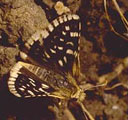Native Plants
Search for native plants by scientific name, common name or family. If you are not sure what you are looking for, try the Combination Search or our Recommended Species lists.
Sphaeralcea coccinea
Sphaeralcea coccinea (Nutt.) Rydb.
Scarlet Globemallow, Caliche Globemallow
Malvaceae (Mallow Family)
Synonym(s):
USDA Symbol: spco
USDA Native Status: L48 (N), CAN (N)
An upright or sometimes sprawling, densely white-hairy perennial, Scarlet Globe Mallow rarely reaches more than 16 inches in height. The plant has several stems and is sometimes found growing in clumps or even extensive colonies. Red-orange or brick-red flowers bloom in narrow clusters and in upper axils on these leafy, branched, velvety-haired plants.
Globe-mallows are common plants on western ranges, but difficult to identify. One of the easiest species to recognize is Scaly Globe-mallow (S. leptophylla) which is covered with gray scale-like hairs and has very narrow upper leaves, not divided or toothed. It grows from southern Utah, southwestern Colorado, and northeastern Arizona to western Texas and northern Mexico.
Plant Characteristics
Duration: BiennialHabit: Shrub
Leaf Arrangement: Alternate
Leaf Complexity: Simple
Breeding System: Flowers Bisexual
Fruit Type: Schizocarp
Size Notes: Up to about 16 inches tall.
Leaf: Green
Bloom Information
Bloom Color: Red , OrangeBloom Time: Mar , Apr , May , Jun , Jul , Aug , Sep , Oct , Nov
Distribution
USA: AZ , CO , IA , ID , KS , MN , MT , ND , NE , NM , NV , OK , OR , SD , TX , UT , WYCanada: SK
Native Distribution: Sask. & Alt., s. to TX, AZ, and Chihuahua in northern Mexico; rare in IA Loess Hills
Native Habitat: Desert plains & mesas; dry, loess bluffs
Growing Conditions
Water Use: LowLight Requirement: Sun
Soil Moisture: Dry
CaCO3 Tolerance: High
Soil Description: Light, gravelly limestone or sandy clay soils.
Conditions Comments: The leaves become thinner, less deeply lobed, and bright green when plants are grown in shade.
Benefit
Use Wildlife: Deer and pronghorn graze this plant, and birds and small mammals eat the fruits.Use Medicinal: Chewed to paste and rubbed over hands making them immune to scalding water. Also applied to inflamed sores and wounds. Tea as lotion for skin diseases, tonic to improve appetite, for rabies. (Kindscher) Blackfoot Indians chewed plant and applied paste to scalds, sores and burns as a cooling agent. (Weiner) Crushed leaves used as poultice for skin irritations. Same crushed leaves used as a shoe liner for blisteded feet. Used by Indians for treating sore eyes.
Use Other: Rich in Vitamin A.
Conspicuous Flowers: yes
Value to Beneficial Insects
Special Value to Native BeesThis information was provided by the Pollinator Program at The Xerces Society for Invertebrate Conservation.
Butterflies and Moths of North America (BAMONA)
|
Small Checkered-Skipper (Pyrgus scriptura)  Adult Food Source |
Propagation
Propagation Material: SeedsDescription: Sow treated seed or take rhizome cuttings in spring. Spring tip cuttings under mist or in a heated frame are another propagation option.
Seed Collection: Seeds are enclosed in a papery crown and are often subject to insect damage.
Seed Treatment: Scarification is beneficial, especially when seeds have been dried and stored.
Commercially Avail: yes
Find Seed or Plants
Find seed sources for this species at the Native Seed Network.
From the National Organizations Directory
According to the species list provided by Affiliate Organizations, this plant is on display at the following locations:Sibley Nature Center - Midland, TX
Native Seed Network - Corvallis, OR
Bibliography
Bibref 1207 - Earth Medicine, Earth Food (1990) Michael A. WeinerBibref 610 - Edible wild plants of the prairie : an ethnobotanical guide (1987) Kindscher, K.
Bibref 1186 - Field Guide to Moths of Eastern North America (2005) Covell, C.V., Jr.
Bibref 1185 - Field Guide to Western Butterflies (Peterson Field Guides) (1999) Opler, P.A. and A.B. Wright
Bibref 946 - Gardening with Prairie Plants: How to Create Beautiful Native Landscapes (2002) Wasowski, Sally
Bibref 355 - Landscaping with Native Plants of Texas and the Southwest (1991) Miller, G. O.
Bibref 995 - Native Landscaping from El Paso to L.A. (2000) Wasowski, S. and A. Wasowski
Bibref 328 - Wildflowers of Texas (2003) Ajilvsgi, Geyata.
Search More Titles in Bibliography
Web Reference
Webref 38 - Flora of North America (2019) Missouri Botanical Garden, St. Louis, MO & Harvard University Herbaria, Cambridge, MA.Webref 23 - Southwest Environmental Information Network (2009) SEINet - Arizona Chapter
From the Archive
Wildflower Newsletter 1984 VOL. 1, NO.2 - Lady Bird Finds Wildflower Lovers Everywhere, Center Expands With New Building, ...Wildflower Newsletter 1990 VOL. 7, NO.4 - Research Update, Wild-Collecting Endangers Natives, Director's Report, Maryland ...
Additional resources
USDA: Find Sphaeralcea coccinea in USDA PlantsFNA: Find Sphaeralcea coccinea in the Flora of North America (if available)
Google: Search Google for Sphaeralcea coccinea
Metadata
Record Modified: 2023-02-28Research By: TWC Staff